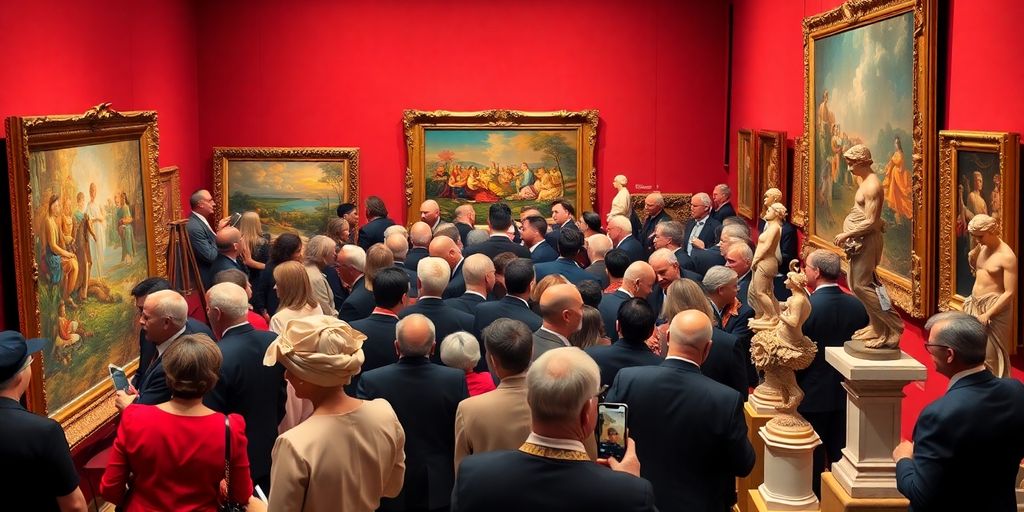Art & Culture
Art Auction Insights: How to Buy and Sell Masterpieces

Art auctions are fascinating events where collectors, investors, and art lovers come together to buy and sell valuable pieces. They offer a unique opportunity to acquire rare artworks while also providing insight into the art market. This article explores the ins and outs of art auctions, from preparation to the auction process itself, helping both buyers and sellers navigate this exciting world.
Key Takeaways
- Art auctions offer a chance to buy unique pieces that may not be available elsewhere.
- Preparation is key: research artworks and set a budget before attending an auction.
- Understanding bidding strategies can increase your chances of success during the auction.
- Post-auction processes are important for ensuring smooth transactions and ownership transfer.
- Choosing the right auction house can make a significant difference in your auction experience.
Understanding Art Auction Insights
The Importance of Art Auctions
Art auctions play a crucial role in the art market. They provide a platform for buying and selling artworks, allowing collectors to acquire unique pieces. Art auctions are not just about prices; they reflect the stories and emotions behind each piece. This makes them significant for both buyers and sellers.
How Art Auctions Influence Market Trends
Art auctions can shape market trends by setting new price benchmarks. When a famous piece sells for a high price, it can increase the perceived value of similar works. Auction results are closely watched by collectors and investors, influencing their buying decisions.
Key Players in the Art Auction World
Several key players are involved in art auctions:
- Auction Houses: These are the organisations that host the auctions, such as Sotheby’s and Christie’s.
- Bidders: Individuals or collectors who participate in the auction to buy artworks.
- Consignors: Those who sell their artworks through the auction house.
| Player Type | Role in Auction |
|---|---|
| Auction Houses | Host the auction |
| Bidders | Purchase artworks |
| Consignors | Provide artworks for sale |
Art auctions are dynamic events that bring together various stakeholders, creating a vibrant marketplace for art enthusiasts.
Preparing for an Art Auction
Researching Artworks and Artists
Before attending an art auction, it’s crucial to do your research. Understanding the artworks and the artists can significantly enhance your bidding experience. Here are some steps to follow:
- Investigate the auction house and its reputation.
- Look into the artists’ backgrounds and their previous works.
- Check the provenance and condition of the artworks.
Setting a Budget and Bidding Strategy
Establishing a budget is essential to avoid overspending. Consider the following:
- Decide on a maximum amount you are willing to spend.
- Plan your bidding strategy, including when to start and how much to increase your bids.
- Be prepared for unexpected competition during the auction.
Registering as a Bidder
To participate in the auction, you must register as a bidder. This process typically involves:
- Providing identification and contact details.
- Agreeing to the auction house’s terms and conditions.
- Receiving a paddle number to use during the auction.
Preparing for an auction is not just about the artworks; it’s about being financially ready and having a clear strategy. Edition pieces are different!
The Auction Process Explained
Cataloguing and Marketing Artworks
Before an auction, artworks are carefully catalogued and marketed. This involves:
- Researching each piece to provide accurate details.
- Creating an engaging auction catalogue that highlights key features.
- Promoting the auction through various channels to attract potential buyers.
Live vs Online Auctions
There are two main types of auctions:
- Live Auctions: Conducted in person, where bidders raise paddles to place bids.
- Online Auctions: Bidders participate through websites, making it easier to join from anywhere.
Both formats have their unique advantages, such as the excitement of live bidding versus the convenience of online participation.
The Role of the Auctioneer
The auctioneer plays a crucial role in the process. They:
- Present each artwork and provide important information.
- Encourage bidding by engaging with the audience.
- Announce the final sale price once bidding concludes.
The auctioneer’s expertise can significantly influence the atmosphere and outcome of the auction.
Summary of Key Points
- Pre-Auction Viewing: Allows buyers to inspect artworks before bidding.
- Registration: Bidders must register to participate, receiving a unique paddle or number.
- Bidding Process: Bidders place bids until no further offers are made, leading to a final sale.
Understanding these elements helps both buyers and sellers navigate the auction landscape effectively.
Important Note
Some artworks may have a reserve price, which is the minimum price set by the seller. If bidding does not meet this price, the artwork may remain unsold.
By grasping the auction process, participants can make informed decisions and engage confidently in the art market.
Bidding Dynamics at Art Auctions
Understanding Bidding Increments
In art auctions, bids typically increase in set amounts, known as bidding increments. These increments can vary based on the current bid amount. Here’s a simple breakdown:
| Current Bid Amount | Bidding Increment |
|---|---|
| £0 – £1,000 | £50 |
| £1,001 – £5,000 | £100 |
| £5,001 – £10,000 | £500 |
| £10,001 and above | £1,000 |
Strategies for Successful Bidding
To navigate the competitive atmosphere of art auctions, consider these strategies:
- Do your homework: Research the artwork and its market value.
- Set a limit: Decide on a maximum bid before the auction starts.
- Stay calm: Keep your emotions in check during bidding wars.
The Impact of Bidding Wars
Bidding wars can significantly affect the final sale price of an artwork. When multiple bidders compete, the excitement can drive prices higher than expected. This dynamic can lead to surprising outcomes, making it essential for bidders to remain focused and strategic.
In the world of art auctions, the thrill of competition can lead to unexpected results, reminding us that art is as much about passion as it is about investment.
Post-Auction Transactions
After an auction concludes, the auction house takes care of the necessary paperwork, including payment and the transfer of ownership. Buyers usually have a set period to complete the transaction, ensuring a smooth process for both buyers and sellers. If an artwork does not sell, the auction house may offer options for post-auction negotiations or explore other sales avenues with the consignor.
Payment and Transfer of Ownership
- The auction house collects payment from the buyer.
- The seller receives the hammer price minus a commission.
- Additional costs may include insurance and catalogue fees.
Post-Auction Negotiations
- If an artwork remains unsold, it can be:
- Returned to the consignor.
- Re-offered at a later date.
- Sold at a smaller auction house for a lower price.
Understanding the post-auction process is crucial for both buyers and sellers, as it helps in making informed decisions about their artworks.
Handling Unsold Artworks
- Unsold pieces are often referred to as “burned” in auction terminology.
- Sellers may receive offers for these artworks at prices slightly below pre-auction estimates.
- The auction house may assist in finding alternative buyers for unsold lots.
In summary, the post-auction phase is vital for ensuring that both buyers and sellers navigate the complexities of art transactions effectively, contributing to a thriving art market.
Navigating Different Auction Houses
Major Auction Houses to Know
When it comes to art auctions, major auction houses play a significant role. Here are some of the most notable ones:
- Sotheby’s: Known for high-value sales and a global presence.
- Christie’s: Famous for its prestigious auctions and diverse offerings.
- Phillips: Focuses on contemporary art and design.
Smaller Auction Houses and Their Benefits
While big names dominate the scene, smaller auction houses can offer unique advantages:
- Personalised Service: Smaller houses often provide more tailored experiences for buyers and sellers.
- Lower Fees: They may charge lower commissions compared to larger houses.
- Niche Markets: They can specialise in specific types of art, making them ideal for collectors looking for unique pieces.
How to Choose the Right Auction House
Selecting the right auction house is crucial for a successful transaction. Consider these factors:
- Reputation: Research the auction house’s history and client reviews.
- Specialisation: Ensure they have expertise in the type of art you are interested in.
- Location: Proximity can affect logistics and costs.
Understanding the different auction houses can help you make informed decisions, whether you are buying or selling art. Each house has its own strengths and weaknesses, so choose wisely!
Opportunities for Bargain Shopping
Bargain shopping at art auctions can be a rewarding experience. You might discover quality pieces at lower prices than galleries. Smaller auction houses often feature works from lesser-known artists that are surprisingly affordable yet still valuable.
Finding Affordable Artworks
- Research the market value of artworks before attending an auction.
- Explore smaller auction houses for unique pieces.
- Attend online auctions for a wider selection.
Researching Market Value
Understanding the market value is crucial. Auction catalogues provide detailed information about each piece, helping you make informed decisions. This knowledge can lead to significant savings.
Utilising Auction Catalogues
- Review auction catalogues for insights on pricing and artist backgrounds.
- Use catalogues to compare similar artworks and their estimated values.
- Keep track of auction results to gauge market trends.
Attending art auctions opens doors to unique masterpieces without breaking the bank. You can find hidden gems that enhance your collection economically.
The Role of Art Advisors

Benefits of Professional Guidance
Art advisors play a crucial role in the art market, offering valuable insights and support to both buyers and sellers. Here are some key benefits of working with an art advisor:
- Expertise in Art Valuation: Advisors have a deep understanding of art history and market trends, helping clients make informed decisions.
- Access to Exclusive Opportunities: They often have connections that can lead to unique artworks not available to the general public.
- Negotiation Skills: Advisors can negotiate better prices and terms on behalf of their clients, ensuring a fair deal.
How to Choose an Art Advisor
Selecting the right art advisor is essential for a successful art transaction. Consider the following factors:
- Experience: Look for advisors with a proven track record in the art market.
- Specialisation: Ensure they have expertise in the specific type of art you are interested in.
- Reputation: Research their reputation and client reviews to gauge their reliability.
Working with Art Consultants
Art consultants can also provide valuable assistance. They often focus on:
- Curating Collections: Helping clients build and manage their art collections.
- Market Analysis: Offering insights into current market trends and future predictions.
- Logistics and Installation: Assisting with the practical aspects of acquiring and displaying art.
Engaging an art advisor can significantly enhance your experience in the art market, making the process smoother and more rewarding. Their expertise can lead to better investment decisions and a deeper appreciation of art.
Unique Experiences at Live Auctions
Attending a live auction can be an exciting adventure. You’re not just buying art; you’re part of a lively event filled with other art lovers and collectors. The energy in the room grows as bidders compete for their coveted pieces.
The Atmosphere of Live Auctions
- Excitement: The thrill of bidding creates a unique atmosphere.
- Community: You meet fellow enthusiasts who share your passion for art.
- Engagement: The live setting allows for immediate reactions and interactions.
Viewing Rare Works Up Close
One of the best parts of live auctions is the chance to see rare works up close before they are sold. This experience can deepen your appreciation for the art and the artists behind it. You can:
- Examine the details of the artwork.
- Understand the craftsmanship involved.
- Feel the emotional connection to the piece.
Participating in the Bidding Process
Bidding at a live auction is not just about buying; it’s about being part of the action. You can feel the excitement as bids rise and fall. Witnessing artists’ recognition and the stories behind the pieces can enhance your understanding of the art world.
Attending a live auction is not just about the art; it’s about the stories, emotions, and connections that come with it.
Online Art Auctions

Advantages of Online Auctions
Online art auctions have become increasingly popular, offering a wide range of artworks at your fingertips. Here are some key benefits:
- Convenience: Participate from the comfort of your home.
- Price Transparency: Clear insights into bidding activity and market demand.
- Diverse Selection: Access to various styles and price ranges.
How to Participate in Online Bidding
To successfully engage in online art auctions, follow these steps:
- Register on the Auction Platform: Create an account to start bidding.
- Research the Artworks: Understand the market value and details of the pieces you’re interested in.
- Set a Budget: Determine how much you’re willing to spend, including any additional fees.
Ensuring Privacy and Security
Maintaining your privacy while bidding is crucial. Here are some tips:
- Use reputable auction sites that prioritise data protection.
- Consider platforms with encryption protocols to secure your information.
- Participate anonymously if desired, using absentee bids or phone bids.
Online art auctions provide a unique opportunity to explore and acquire art without the pressure of traditional bidding environments. They democratise the art-buying process, allowing everyone to participate based on their bids alone.
In summary, online art auctions are a fantastic way to discover and purchase unique pieces while ensuring a secure and private experience. Whether you’re a seasoned collector or a first-time buyer, these platforms offer something for everyone.
Marketing and Promotion of Artworks
Effective marketing and promotion are essential for attracting potential buyers to your artworks. Here are some key strategies to consider:
Creating an Effective Auction Catalogue
- High-quality images: Use professional photographs to showcase your artwork.
- Detailed descriptions: Include information about the artist, the artwork’s history, and its significance.
- Provenance: Document the artwork’s ownership history to build trust with buyers.
Utilising Digital Marketing Strategies
- Social media: Share your artworks on platforms like Instagram and Facebook to reach a wider audience.
- Email newsletters: Keep your subscribers updated on upcoming auctions and new pieces.
- Art-specific websites: List your artworks on platforms dedicated to art sales to attract serious buyers.
Engaging High-Profile Clients
- Networking events: Attend art fairs and exhibitions to connect with collectors and influencers.
- Private showings: Offer exclusive previews of your artworks to select clients.
- Collaborations: Partner with other artists or brands to expand your reach.
Remember, the right marketing strategy can significantly enhance the visibility of your artworks and attract the right buyers.
By implementing these strategies, you can effectively promote your artworks and increase your chances of successful sales. 10 art marketing tips to promote your art include creating sellable art by imagining your ideal buyer, diving into new markets, and reimagining your art’s potential.
Conclusion
Art auctions are thrilling events that unite collectors, investors, and art lovers in a lively setting where artworks are bought and sold. From the careful preparation and detailed cataloguing to the exciting bidding process, auctions offer a unique chance to value and exchange precious pieces of art. By grasping how art auctions function, both buyers and sellers can confidently navigate this intricate world, enriching the vibrant and ever-changing landscape of art.
Frequently Asked Questions
What should I know before attending an art auction?
Before going to an art auction, it’s important to research the artworks and artists. Make sure you understand the auction house’s rules and how the bidding process works.
How can I set a budget for bidding?
Decide how much you are willing to spend before the auction starts. It’s easy to get carried away, so stick to your budget.
What is the role of an auctioneer?
The auctioneer is the person who leads the auction. They call out the bids and help keep the event moving smoothly.
Can I bid online?
Yes, many auction houses offer online bidding. You can participate from the comfort of your home.
What happens if an artwork doesn’t sell?
If an artwork doesn’t sell, the auction house may discuss other selling options with the owner.
How do I know if an artwork is authentic?
Auction houses provide detailed information about each artwork, including its history and condition, to help buyers verify authenticity.
What are bidding increments?
Bidding increments are the minimum amounts that bids must increase by. This helps keep the bidding process organised.
Should I consider hiring an art advisor?
Yes, hiring an art advisor can be helpful. They can guide you in choosing artworks and navigating the auction process.
-

 Blockchain Technology6 days ago
Blockchain Technology6 days agoBlockchain Beyond Cryptocurrency: 5 Game-Changing Applications You Should Know
-

 Business7 days ago
Business7 days agoStock Futures Soar as US-China Trade Talks Yield Positive Results
-

 Fitness & Wellness5 days ago
Fitness & Wellness5 days agoAre Smartwatches Worth It? The Best Wearable Tech of 2025
-

 Government7 days ago
Government7 days agoU.S. Government Intensifies Scrutiny of Social Security Notices Amid Funding Concerns
-

 Politics6 days ago
Politics6 days agoTrump’s Administration Races Against Time to Prevent Government Shutdown
-

 Stock Market6 days ago
Stock Market6 days agoUS-China Tariff Truce Ignites Stock Market Rally
-

 Stock Market5 days ago
Stock Market5 days agoUS-China Tariff Agreement Fuels Stock Market Rally
-

 Business5 days ago
Business5 days agoChavez-DeRemer Unveils Historic Investments to Empower American Workers


















